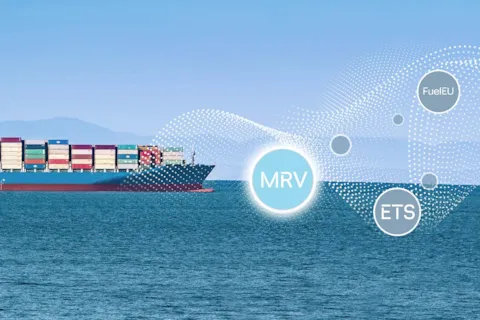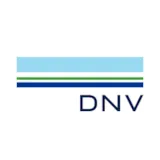Get regular maritime industry insights!
Join more than 70.000 of industry insiders today who have already signed up to receive the latest insights.
Sign up
Emissions for the EU Emission Trading System (EU ETS) will be reported and verified through the EU MRV system, which will be revised to cover GHG emissions, ship types and sizes. DNV expert Sven Dudszus shares insights on what these changes mean for the reporting process and compliance.

Sven Dudszus currently holds the position of Head of Environmental Technologies GHG at DNV in Hamburg, Germany. He manages an international team across different locations responsible for greenhouse gas-related services for the shipping industry such as EU MRV, UK MRV, IMO DCS, EU ETS, FuelEU, SEEMP III, CII and Fit for55.
Can you give a brief overview of the current MRV (Monitoring, Reporting and Verification) reporting process and the challenges that still need to be addressed?

Currently, the EU MRV regulation applies to cargo and passenger ships above 5,000 GT operating in European Economic Area (EEA) waters. Since 2017, these vessels have been required to monitor and collect CO2 emissions data for EU-related voyages. The collected data is submitted as an Emission Report for verification to the European Commission by 30 April of the following year. One of the challenges faced by customers is ensuring the accuracy and quality of the data. At DNV, we have established digital reporting forms and automated data checks to address this challenge. This enables our customers to monitor their vessels' data quality throughout the year and easily submit the Emission Report for verification. Our close collaboration with customers has made this process seamless for them.

How does the implementation of the EU Emission Trading System (ETS) impact MRV reporting going forward?

The implementation of EU ETS complements the existing EU MRV and UK MRV initiatives, forming a comprehensive decarbonization framework. Under the EU ETS, companies will be required to submit not only their vessels’ Emission Reports for verification but also a Company Emission Report summarizing their entire fleet’s performance. Additionally, managers will need to surrender greenhouse gas emission allowances to the administering authority. At DNV, we utilize the operational data received from our customers. This will enable them to create customized GHG reports to facilitate compliance with these new requirements.

Are there any key dates or numbers that are crucial in this change?

The deadline for the first Company EU MRV Emission Report submission to the Administering Authority is 31 March 2025. The deadline for surrendering allowances to the Administering Authority is 30 September 2025. 100% of GHG emissions will be considered for voyages or port stays within the EU and EEA as applicable. 50% of GHG emissions will be considered for voyages into or out of the EU. EU Allowances (EUAs) will be corresponding to 40% of the company emissions in 2024 and this percentage will gradually increase in subsequent years.

How can additional emissions impact compliance matters?

Including additional emissions would require companies to surrender more allowances to the Administering Authority. Failure to fulfil these requirements could result in liability for excess emissions with a penalty of 100 euros applicable per ton of CO2. Companies would still be obligated to surrender the required allowances. Non-compliance with the regulation for two or more consecutive periods may lead to denial of entry to the EU for all ships under the company’s responsibility.

What challenges do shipowners face and how can DNV support them in navigating these challenges?

Shipowners will face an expansion of the EU MRV scope which will include new greenhouse gases (N2O, CH4) starting in 2024. As of 2025, General Cargo and Offshore vessels above 400 GT will also be subject to the EU MRV Regulation. DNV’s digital solutions such as a plan generator, data quality checks, or system-to-system connection (API) have been developed to address these new regulatory requirements. Furthermore, we will continuously develop our digital GHG-related services and applications to assist our customers in initiating their decarbonization journey.

As the EU ETS changes approach, how important is preparation?

Preparation is crucial for companies to be ready to comply with the new regulations when they take effect. The first step is to submit an updated EU MRV Monitoring Plan to DNV once the revised regulations come into force. All applicable vessels must have a verified plan on board before the 2024 reporting period. To support our customers in meeting this deadline, we will release an update to our MRV Monitoring Plan Generator on our Fleet Portal. From 2024 onwards, we will develop various digital systems to aggregate fleet emissions and issue Company CO2 Emission Statements, which need to be submitted to administering authorities by 31 March. The second step is to register with an administering authority in the EU, when the European Commission has provided the related list of assignments. This is to be expected by beginning 2024.

In the first episode of series five of DNV’s Maritime Impact podcast, Eirik Nyhus assesses the state of play for the EU ETS and the FuelEU Maritime.
Get all insights on EU MRV, UK MRV and related support
Learn more about the upcoming regulation
Join more than 70.000 of industry insiders today who have already signed up to receive the latest insights.
Sign up